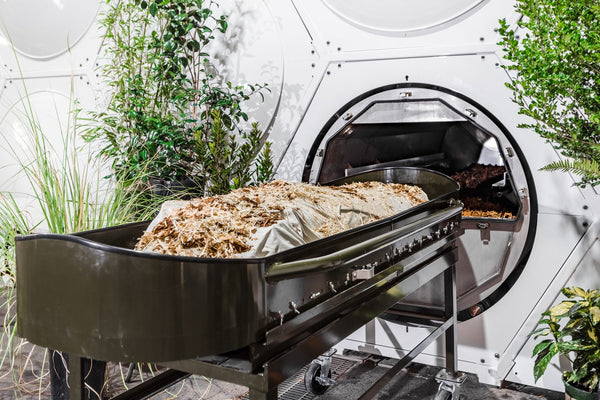Composting: the beginning of a sustainable end
Many of us are familiar with composting green waste, to eventually use it to improve the soil of our vegetable gardens. But what does this process have to do with a funeral? In recent years, there has been increasing attention for human composting, also known as vergronden. In Washington, this method has been allowed since 2019, and in Germany since 2022. In many other European countries, there is extensive research into the benefits of this sustainable funeral method. That is why we are already telling you everything about composting.
Giving back to the earth
Composting is a process in which the body of a deceased person is broken down into nutritious soil, compost or humus, without the use of chemicals or combustion. The body is placed in a special composting unit, in which the natural decomposition cycle is accelerated. In this way, the body is returned to the earth in a natural and efficient way. This is also the reason that the term 'veraarden' is increasingly used in the Netherlands.
Composting, how does it work?
How exactly does composting work? In the composting unit, ideal conditions are created for microorganisms to break down the body. It is like a controlled environment in which the climate is regulated in detail. A perfect balance of humidity, oxygen and temperature is created, which ensures an optimal living environment for microorganisms.
Composting, step by step
To take you through how it works, we use the model of the American company Recompose. In addition, we describe the shrouding of the body prior to placement in the cocoon. Although this is not done that way in America, it will probably become a requirement for the process in Europe.

- The placement
The body is placed in a 'cocoon', a kind of capsule that is specially designed for human composting. Inside, the body is enveloped in wood chips, alfalfa and straw. The amounts of this material are completely adjusted to each body. The capsule is closed, and the transformation into compost begins.
- Microbial degradation
The duration of the process varies per organization. Recompose calculates five to seven weeks for this, while Meine Erde assumes 40 days. During this period, the body and the plant materials remain in the capsule, and the body is slowly broken down by microorganisms. No chemicals or additives are used. The microorganisms generate temperatures of up to 70° Celsius. These temperatures destroy harmful pathogens and transform the body into fertile humus that is safe for humans and plants. The result of this breakdown process is that nutrient-rich soil is created: compost.
- Compost
Per body, approximately 0.75 cubic meters of usable compost is created. This raw material is removed from the capsule, and is stored in America for three to five weeks to allow it to air (in Germany this is not done, because there it is required by law to bury this compost, where the raw material ripens by itself). After this process, the compost can be used to enrich the soil of forests, gardens, and all other forms of nature.
- Life after death
This nutritious raw material gives the nutrients of our body back to nature, so to speak. It can be used for the restoration of forests, it stores carbon, and it feeds new life. It is also possible to use the compost as food for planting a tree in memory of the deceased.
Where can I humanely compost right now?
If you choose to compost, you will have to go abroad (for now). Fortunately, you don't even have to go that far: in 2022, the German Meine Erde was the first in Europe to start human composting, also called Reerdigung . And in the state of Washington in America, Recompose has been offering the option of vergronden since 2019.
Composting in the US: Recompose
The Recompose team:

One day, while playing with her young son in the backyard, Founder Katrina Spade began to contemplate the idea that would become Recompose. “It was during that time that he seemed to be growing up so fast,” she recalls. “One day he’ll be 40, I thought. Oh wow… I’ll be over 70! That realization inspired me to think about my own mortality.” A realization that permeated her studies in architecture at the University of Massachusetts.
It was here that Katrina began to think about the environmental impact of traditional burial and cremation. “When I die, I’ll probably be cremated,” she thought. “I want a natural burial, but I want to live in a city. Should I go back to the countryside to be buried? How do you bring nature into the city funeral?”
While in college, Katrina’s childhood friend Kate Stephenson called her. “Did you know that farmers have been composting animals for decades?” The conversation got Katrina thinking: What if you could do the same with people? During her sophomore year of college, Katrina and friends Garth and Jesse built a compost heating system, demonstrating the incredible power of microbes. With her groundbreaking approach to funeral care, Katrina eventually founded Recompose, a company dedicated to offering ecological composting as an alternative to traditional burial and cremation.
To date, Recompose has composted nearly three hundred bodies, a success that has led to the launch of two other natural organic decomposition companies: Return Home and the Herland Forest Natural Burial Ground.
After the treatment, these three American parties offer the possibility to collect the remaining fertile soil or donate it to a local forest. The choice here does differ: at Recompose, half chooses the forest, but at Return Home only five percent donates. At natural burial ground Herland Forest it is also possible to choose a natural grave, which more than 80 percent chooses.
Composting in Germany: Meine Erde
Meine Erde founders Max Huesch and Pablo Metz:

"Listening to our grandparents' stories, we were impressed by their commitment to their legacy and their desire for a positive approach to saying goodbye. We set out to find a way of saying goodbye that would do justice to the beautiful memories of the survivors. The concept of not disappearing completely, but rather creating new life, offers comfort and hope. The idea that a tree can grow from the soil of our loved ones, on which future generations can climb and pick cherries, is a wonderful alternative, both for those who leave and for those who remain. This is how the concept of Meine Erde came about."
At the moment Meine Erde is working with the University of Leipzig to make Reerdigung (re-earthening) accessible. The results of all the research they do will be made public, so that the process can be approved throughout Europe.
Composting in Belgium: Humusation
In Belgium, there has been a growing movement for some time to make composting, known in Belgium as humusation , possible. The Metamorfose Foundation, which now has more than four hundred members, is currently investigating the possibilities of open-air composting. This can be seen as a method that is close to how it is done in the garden: a compost heap is made in a so-called metamorphosis garden. This uses the microorganisms that already live in the top layer of our soil, together with additional bacteria that are actively added to the heap. Their website states that they expect that the remains will be transformed into a healthy and fertile humus (the official term for the fertile top layer of the soil) after twelve months using this natural method. Since March 23, 2023, tests have been running with four pigs, a study that they say is almost completed. With these results, they expect to receive permission for human testing soon.
Composting in the Netherlands
In the Netherlands, there is a growing interest in composting. The number of individuals and companies in the funeral industry who are committed to making composting possible in the Netherlands is growing rapidly. A foundation has also been established called Veraarden , a group of eight researchers, including GreenLeave chairman Evert de Niet, Immanuel Baan, Susanne Duijvestein, Marly van Lipzig and Jurrien Roossien, who are committed to making this sustainable funeral method possible in the Netherlands and having it included in the law on funeral services. In the spring of 2023, they went to Meine Erde, hoping to use their experiences to accelerate this legalization process in the Netherlands.

Since then, composting has received a lot of attention in the funeral media. For example, the Brancheblad Uitvaartzorg wrote three enthusiastic articles about it in a short period of time. Chief editor Anja Krabben of De Begraafplaats writes: "Let me serve as food for my own garden after my death, where I was so often happy", and Dela spokesperson Ria Luichies cannot deny the attention: 'the latest hype'.
Update June 2023
At the moment, there are discussions going on between various umbrella organizations from the funeral industry and the Ministry of the Interior and Kingdom Relations ( BZK ). These discussions are about changing the law on funeral services so that it becomes easier to include innovative methods of funeral services in the law. The ministry has indicated that it is positive about this. In addition, the available data on composting is being investigated with the aim of being able to present this to the Health Council so that they can give a positive recommendation to include composting in the law on funeral services.
Wikkelgoed and composting
An important ongoing research is finding suitable materials for the wrapping of the body. Most materials have a slowing effect on the process. However, it is very important that the deceased is shrouded respectfully. Together with Meine Erde, Wikkelgoed has started research into suitable materials that can be used as composting shrouds that promote the decomposition and at the same time allow for a dignified farewell.
Why compost?
Why is it necessary to make another method of funeral care possible in addition to burial and cremation?
- Sustainability:
Composting as a funeral method offers a sustainable approach to body disposal. The process uses natural decomposition and microbial activity to return the body to the earth, resulting in the production of nutritious compost. It minimizes environmental impacts compared to traditional methods, such as preserving land for burial sites and reducing emissions from cremation.
- Lack of space:
In many areas, available space for burial sites is becoming increasingly scarce. Traditional burial practices often require large areas of land for burial sites, as well as the use of graves and headstones. Human composting offers a space-saving solution, as it does not require permanent grave markers. This helps preserve natural habitats and makes more efficient use of available space.
- Personal preferences:
Not everyone is comfortable with the traditional methods of burial or cremation. Some people seek alternatives that better align with their personal beliefs, cultural background, or spiritual and holistic values. Composting can offer a more natural and connected approach, returning the body to the earth in a way that is harmonious with the natural cycle.
- Innovation and freedom of choice:
Composting as a funeral method not only offers sustainability and space saving, but also innovation and freedom of choice. It stimulates new developments in the field of funeral care and gives people the freedom to choose a method that fits their values, wishes and environmental awareness.
- Connectedness with nature and the end of life
Human composting offers a deeper connection to nature and the end of life. The idea of returning to the earth and contributing to the continuation of life can provide a sense of peace and harmony, both for those who make this choice and for their loved ones.
- A respectful and meaningful way to say goodbye
By returning the body to nature in a natural way, natural, living memorials are created. Life does not have to be commemorated at a gravestone in a strictly arranged cemetery, but can take place in a nature reserve. Coupled with the beauty of nature, there is also the realization that the deceased has directly contributed to its maintenance and life.
New opportunities in the funeral industry
There is a notable shift in social norms and perceptions surrounding death and funerals. People are becoming increasingly aware of the ecological impact of traditional funeral practices and are looking for more environmentally friendly alternatives, including human composting and also resomation . Traditional funerals were previously considered the only “right” way to show respect for the deceased and to go through the grieving process. However, in line with the growing focus on sustainability and environmental awareness, people are beginning to broaden their horizons and become open to new approaches. More and more people are choosing to live their lives in harmony with nature, the more holistic view of life. They are looking for ways to have a positive impact on the world even after death. Human composting ties in nicely with these values, as it is not only a sustainable method, but also returns the body’s nutrients to the earth.
The beginning of a sustainable end
The future of human composting looks promising. Research and innovation will continue to improve the process and the techniques used. New methods and technologies are being developed to further optimize the composting process, making it more efficient and effective.
In the meantime, it is essential to increase awareness and education about human composting so that people can make informed choices about their funeral. Through education, people can better understand the benefits and possibilities of human composting and consider it as an alternative to traditional burial practices. Promoting open dialogue and sharing experiences can help to increase the acceptance and normalization of human composting.
We look ahead with enthusiasm and are committed to a future in which composting is made possible in the Netherlands.
Composting and the Burial Act
The Burial and Cremation Act is currently being updated in the Netherlands, a process that has been significantly delayed due to the Covid period. This includes looking at resomation and composting, based on an advisory report from the Health Council in 2020. At the time, there was insufficient information to properly assess human composting, but a lot has happened in recent years. Since there is already a location in Germany that makes this form of funeral possible, more and more information and data has become available. The Veraarden Foundation, among others, is committed to legalizing composting in the Netherlands as well.
The cost of composting
What composting, or earthing, would cost in the Netherlands is of course not yet certain, but we can already look ahead by looking at our predecessors. Industry magazine Uitvaartzorg has made a handy overview for this:

If you look at our German neighbours, it could well be that Composting will become the cheapest funeral method in the future. Together with the sustainability arguments, and the idea of becoming part of nature, we are very much looking forward to the arrival of veraarden!
Header: Recompose.life


